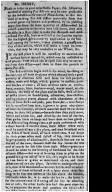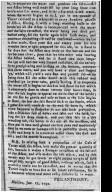[ Method of Making Pot Ash ] Philanthropy
Date: 1792/01/17
Source:
Royal Gazette and the Nova Scotia Advertiser.
Institution: Nova Scotia Archives
| Source Origin: Nova Scotia Newspapers on Microfilm
| Reference: Consult the Nova Scotia Archives' "Nova Scotia Newspapers on Microfilm" list (Royal Gazette) for a complete account of microfilm reels for this paper. EMMR includes recipes from Microfilm Reels 8162, 8163, 8165, and 8167.
Instructions for making fertilizer from wood ashes and plant salts. Vol. 3, No. 148. Microfilm Reel 8163.
Mr. Henry,
Please do insert in your respectable Paper, the following
method of making Pot Ash--it may be very profitable
to the industrious farmers of Nova-Scotia, as this me-
thod of making Pot Ash differs materially from that
process generally known and practiced, by its yielding
more salts from the same quantity of Ashes--and by
a strict attention to the rules here laid down, they may
be able in a short time to make the sharpest and most
refined Pot-Ash, such as will sell at the London market
for the highest price--and by application in the busi-
ness among the farmers, it may produce a great quan-
tity of that article, which will make a large exporta-
tion, that may be very condusive to our Wheel, &c.
IN the first place it will be necessary to mention the
various sorts of materials, which may be collected in
most places, from which the sharpest salts may be extrac-
ted from their Ashes--and then to shew the process to
make Pot-Ash.
The first article to begin with is sea-weed, sea-thong or
sea-lace, and all herb or plants which abound with a good
Quantity of alkatious salts will serve for this purpose,
rushes, reads and sedge, which growes in mashes, poole
and ditches of water; all sorts of bitter herbs as cardus,
bens, centory, hops, southern-wood, worm-wood, as also
tobacco, the body of the plant and its stalk, with all sorts
of milky plants, as dandelyons, celandine, sow-thistles,
and leguminous plants abound with abundance of this
salt, as bean-stalks and pods, peas-straw, &c. very sharpe
salt is extracted from fern, it grows in great abundance
all over the Country, all these materials must be cut down
when in their full prime, --because then they yield more,
better and whiter salt, and dried by the heat of the sun,
then gather them on heaps and burn them on iron grates;
the Ashes falling through into a pit made underneath with
a stone hearth to receive them, these Ashes when cold,
must be carried into a dry place, and may be mixed with
the Ashes of hard wood, all hard wood trees, if cut down
in their prime when most fullest of sap, they contain a
larger quantity of alkatious salt, then those that are cut in
the fall of the year, because then the sap leaves the tree
and of course the less salts from their Ashes--great care
should be taken in the burning of hardwood for the sake
of their Ashes--that way of burning them in piles on the
ground is a great loss of their salt, they ought to be burnt
on iron barrs or grates as mentioned above, and their
Ashes carried to a dry place. In order to undergo the pro-
cess, now to be mentioned--wo iron kettles well be neces-
sary, one of them to be cast with a spout about three feet
long to be fourteen inches in the side above the bottom,
this kettle when set, is to make the lye in; the spout is
for the convenience of drawing off the lye in wooding
fats or tubs, the other kettle is to boil the pure clear lye
in, to evaporate the water and produce the salts.--All
in, to evaporate the water and produce the salts. --All
our Ashes being well made fill up your long spout iron
kettle with fair water, and make a fire with dried wood,
when the water begins to boil, put in ten-pounds of
Tarter calcined to a whiteness to every hundred pounds
of Ashes, stirring it with a long wooding ladle in the
kettle till all the Ashes is incorporated with the water
and the salts extracted, the water being one third part
boiled away, fill the kettle again with fresh water, and
continue the boiling till half be consumed--when the lye
is thus made, slack your fire and empty your lye into
wooden fatts or tubs prepared for this use, let it stand so
six days that the Ashes may settle to the bottom and the
lye become clear, pour that lye into other tubs leaving
the Ashes behind, and let it stand two days longer
the lye will become very limped and clear, all the earthly
faces precipitating and settling at the bottom, continue
thus three times, and you will have a clear and limpid
lye which will yield a very fine and perfect salt--this
being done fill the other kettle with this refined and
clarified lye in your tubs, gently boiling it to evaporate
the water till it begins to thicken and shoot its salt which
it commonly does in about twenty four hours time, so
that the salt begins to appear on the surface of the kettle;
let the fire be gentle and easy as soon as the salts begins
to shoot, for fear the salt should stick to the kettle, which
a great fire will cause it to do and so burn it, which
often happens to those that do not take such precaution,
take a scimmer full of holes and take out the salts, let-
ting the lye drop from it, and put this salt in a dry
wooding tub, the better to dry out all the moisture, and
then put it into well glazed earthen pans and moderately
heat in an oven or furnace till it is perfectly dried, take
it out and keep it in a covered vessel from the dust and
air; and the matter it compleat.
N. B. In mixing such a proportion of the Calx of
Tarter with the Ashes, is to make the greater quantity of
salt, because it makes a stronger attraction of the salt out
of the Ashes, and also makes the salt whiter, and by this
means may be got seven or eight pound weight of salts
out of fifty weight of good Ashes, without which, such a
quantity could not be extracted, and to notice that the
Tarter ought to have five or six hours calcination, for so
it becomes whiter and more easily dissolveable in water.
PHILANTHROPY.
Halifax, Jan. 17, 1792.
Download: Transcription | Images

